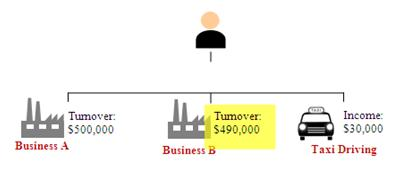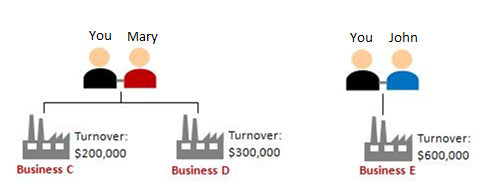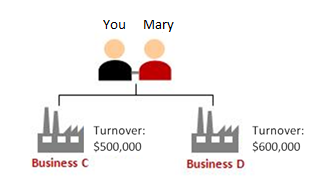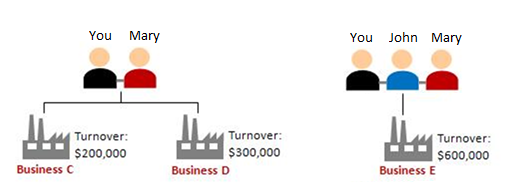Compulsory registration
You must register for GST if your taxable turnover is:
- Under the retrospective view, more than $1 million at the end of the calendar year, or
- Under the prospective view, expected to be more than $1 million in the next 12 months
What is taxable turnover?
Taxable turnover refers to the total value of all taxable supplies made in Singapore in the course or furtherance of businesses, which include:
- standard-rated supplies (e.g. local supply of goods or services including the supply of imported low-value goods to individuals and businesses in Singapore that are not registered for GST from 1 Jan 2023), and
- zero-rated supplies (e.g. export of goods or supply of international services ),
but exclude:
- exempt supplies (including exempt supplies that fall within the definition of international services, e.g. financial services provided to overseas persons, and are thus zero-rated),
- out-of-scope supplies, and
- sale of capital assets (e.g. sale of machinery, equipment, office building and furniture).
If you are not liable for GST registration, you may choose to register voluntarily after careful consideration.
You may also be liable for GST registration under the Reverse charge and Overseas vendor registration regime. For more information, please refer to the section on Reverse charge and overseas vendor registration below.
All currency/ monetary amounts stated in this webpage refer to Singapore dollars.
Retrospective view
Under the retrospective view, you are to assess if your taxable turnover for the calendar year (i.e. for the period 1 Jan to 31 Dec) exceeded $1 million. If it did, you must apply for GST registration between 1 Jan to 30 Jan of the following year. You will then be registered for GST on 1 Mar of the following year.
[Note!] If your taxable turnover exceeded $1 million during the year before the calendar year ends AND you do not reasonably expect your taxable turnover to be more than $1 million in the next 12 months (i.e. prospective view does not apply), you are not required to register immediately.
You can either:
- Wait till the calendar year ends, and apply for compulsory GST registration under the retrospective view between 1 Jan to 30 Jan of the following year (unless you qualify for the exception from registering for GST); or
- Apply for voluntary GST registration at any time if you fulfil the conditions.
You are encouraged to use the GST Registration Calculator to assist you in determining your GST registration liability.
| Scenario | Dates to apply for GST registration | Effective date of registration |
|---|---|---|
| Your taxable turnover from 1 Jan to 31 Dec 2025 exceeded $1 million | 1 to 30 Jan 2026 | 1 Mar 2026 |
Prospective view
At any point in time, if you can reasonably expect your taxable turnover to be more than $1 million in the next 12 months, you must apply for GST registration within 30 days after the date of your forecast, and you will be registered on the 31st day after your forecast date.
[New!] The Second Minister of Finance has announced on 28 Feb 2025 that businesses liable for GST registration on a prospective basis will be given a two-month grace period to start charging GST. Prior to this, businesses are required to charge GST on the 31st day after the date of forecast.
If your liability to register for GST under the prospective basis arises on or after 1 Jul 2025, you will be registered 2 months from the date of your forecast. However, you are still required to apply for GST registration within 30 days after the date of your forecast.
Please refer to Example 2a and 2b for more details.
You must have supporting documents to support your forecast value of $1 million. For example:
- Signed contracts or agreements
- Accepted quotations or confirmed purchase orders from customers
- Invoices to customers with fixed monthly fee charged
- Income statements showing that past 12-month period was already close to $1 million and that annual turnover is on an increasing trend
On the other hand, you are not required to register for GST if there is no certainty in your forecast. For example, you made a forecast based on market assessment, business plans or sales targets.
The effective date of registration will be on the 31st day after the date of forecast.
| Date of forecast before 1 Jul 2025 | Due date to apply for GST registration | Effective date of registration |
|---|---|---|
| Contract or agreement with more than $1 million value signed on 1 Jul 2024 | 31 Jul 2024 | 1 Aug 2024 |
| Quotation with more than $1 million value accepted by customer on 2 Sep 2024 | 2 Oct 2024 | 3 Oct 2024 |
| Past 12-month turnover as at 31 Dec 2024 was $900,000. As turnover has increased by 15% on year-to-year basis, turnover for next 12 months projected to be more than $1 million on 15 Jan 2025 | 14 Feb 2025 | 15 Feb 2025 |
| Secured a tender on 31 Dec 2024 with more than S$1 million value, for a project to be invoiced by the next 12 months | 30 Jan 2025 | 31 Jan 2025 |
The effective date of registration will be 2 months from the date of forecast. The timeline to apply for GST registration remains unchanged. You are still required to apply for GST registration within 30 days after the date of your forecast.
| Date of forecast on or after 1 Jul 2025 | Due date to apply for GST registration | [New!] Effective date of registration |
|---|---|---|
| Contract or agreement with more than $1 million value signed on 1 Jul 2025 | 31 Jul 2025 | 1 Sep 2025 |
| Quotation with more than $1 million value accepted by customer on 2 Sep 2025 | 2 Oct 2025 | 2 Nov 2025 |
| Past 12-month turnover as at 31 Dec 2024 was $900,000. As turnover has increased by 15% on year-to-year basis, turnover for next 12 months projected to be more than $1 million on 15 Jan 2026 |
14 Feb 2026 |
15 Mar 2026 |
| Secured a tender on 31 Dec 2025 with more than S$1 million value, for a project to be invoiced by the next 12 months |
30 Jan 2026 |
28 Feb 2026 (non-leap year) |
| Secured a tender on 31 Dec 2027 with more than S$1 million value, for a project to be invoiced by the next 12 months |
30 Jan 2028 |
29 Feb 2028 (leap year) |
Exception
You will not be required to register for GST if:
a. Your taxable turnover is derived wholly or mainly from zero-rated supplies and you apply for exemption from registration.
b. You are liable for GST registration under the retrospective view but not under the prospective view and the following conditions are met:
You are certain that your taxable turnover for the next 12 months will not exceed S$1 million
The taxable turnover is projected to be lower due to specific circumstances(e.g. large-scale downsizing of business)
- You have supporting documentation to substantiate your projection
You must nonetheless continue to monitor your taxable turnover at the end of the next calendar year.
To support your position that you are not liable to register under retrospective view, you must maintain:
(a) Documentary evidence to prove that the specified circumstances below apply to you; and
(b) Detailed computation showing how the projected taxable turnover for the next 12 months will not exceed $1million.
| Specified circumstances | Examples of supporting documents | |
|---|---|---|
1 | Expiry/termination of high-value sales contract from a major customer and you are unlikely to enter into new sales contracts in the next 12 months |
|
2 | Large-scale downsizing of business e.g. divestment of certain business lines, cessation of manufacturing activities, closure of retail shops/outlets, or relocation of business activities to overseas |
|
3 |
Revocation of business licence or termination of sales distribution rights |
|
4 |
Cessation of all business activities or preparation to wind up, dissolve or strike-off business |
|
Reverse charge and overseas vendor registration
You may also be liable for registration:
- under the reverse charge regime if your business procures services from overseas suppliers or imports low-value goods and your business is not entitled to full input tax credit even if it is GST-registered, or
- under the overseas vendor registration regime if you are an overseas supplier or a local/ overseas electronic marketplace operator or redeliverer that provides services (digital and non-digital) or supplies imported low-value goods to individuals and businesses in Singapore that are not registered for GST.
For more information on the requirement to register for GST under these regimes, please refer to our webpage on GST on imported services.
Late notification of liability for GST registration
There are serious consequences for late registration:
- Your date of registration will be backdated to the date you ought to be registered for GST.
- You will have to account for and pay GST on your past sales starting from the effective date of registration, even if you did not collect any GST from your customers.
- You may face a fine of up to $10,000 and a penalty equal to 10% of the GST due for late notification. Prosecution action may apply.
If you submit an application for GST registration and voluntarily disclose that you are late in registration, we will generally waive the late notification fine and penalties. However, you will still have to account for and pay GST on your past sales from your effective date of registration. If you have difficulties paying the GST due on the backdated period, we may allow you to pay the GST due in instalments.
Computing your business turnover
The table below explains the different methods used to compute your business taxable turnover, depending on whether you are a sole-proprietorship, a partnership, or a private limited company.
| Sole-proprietorship (Individual) | Partnership | Company (e.g. Private Limited Company) | |
|---|---|---|---|
How do I compute business turnover? | Combine the turnover of:
Refer to example below for illustration. | Combine the turnover of all partnership businesses with the same composition of partners (including rental of commercial properties, rental of furniture & fittings and home-based business), regardless of whether the businesses are registered with ACRA. Please refer to example below for illustration. | Compute the turnover of that single company (including rental of commercial properties, and rental of furniture & fittings). If your company (as a legal entity) owns sole-proprietorship businesses, you need to combine the turnover of
|
How will my businesses be registered for GST? | All your businesses under your name will be registered in the name of the sole-proprietor (i.e. your name) irrespective of the turnover of each business. This includes sole-proprietorship businesses which you may set up in the future. | Each partnership business that is required to register for GST will be separately registered under its own name. Once your partnership is GST-registered, all businesses with the same composition of partners need to be GST-registered. This includes businesses with the same composition of partners which you may set up in the future. | GST registration will be in the name of your company. |
You have two sole-proprietorship businesses (Businesses A and B). You also drive a taxi on a part-time basis.
In the past 12 months:
- Business A turnover is $500,000.
- Business B turnover is $490,000.
- Income derived from taxi driving is $30,000.

To compute your business turnover:
- Combine the turnover for Business A, Business B and the income derived from taxi driving.
- Total Turnover/Income: $500,000 + $490,000 + $30,000 = $1,020,000
- The combined turnover (including the income from the taxi driving) exceeds $1 million.
- You must register for GST immediately if you can reasonably expect your total turnover to be more than $1 million for the next 12 months.
Scenario 1:
You and Mary own two partnership businesses (Businesses C and D). You also own a partnership business (Business E) with John.
In the past 12 months:
- Turnover of Business C is $200,000
- Turnover of Business D is $300,000
- Turnover of Business E is $600,000

To compute your business turnover:
- Combine turnover of all partnership businesses with the same composition of partners.
- Combined Business Turnover of Business C and D (which you own with Mary) is $200,000 + $300,000 = $500,000, which is less than $1 million.
- You need not register Businesses C and D for GST if you expect combined Business Turnover to be less than $1 million for the next 12 months.
You should calculate the business turnover for Business E separately because you have a different business partner - John. In this case, as the Business Turnover of Business E is less than $1 million ($600,000), you do not need to register Business E for GST.
Scenario 2:
You and Mary own two partnership businesses (Businesses C and D).
In the past 12 months:
- Turnover of Business C is $500,000
- Turnover of Business D is $600,000

To compute your business turnover:
- Combine turnover of all partnership businesses with the same composition of partners.
- Combined Business Turnover of Businesses C and D (which you own with Mary) is $500,000 + $600,000 = $1,100,000, which exceeds $1 million.
- You need to register your partnership Businesses C and D for GST immediately if you reasonably expect your business turnover to be more than $1 million for the next 12 months.
- Upon registration, each of your partnership businesses will be registered under their own individual GST registration number and you will need to file separate GST returns for them.
Scenario 3:
You and Mary own two partnership businesses (Businesses C and D). You, Mary, and John also own one partnership business (Business E).
In the past 12 months:
- Turnover of Business C is $200,000
- Turnover of Business D is $300,000
- Turnover of Business E is $600,000

To compute your business turnover:
- Combine turnover of all partnership businesses with the same composition of partners.
- Combined Business Turnover of Businesses C and D (which you own with Mary) is $200,000 + $300,000 = $500,000, which is less than $1 million.
- You need not register Businesses C and D for GST if you expect your business turnover to be less than $1 million for the next 12 months.
You should calculate the business turnover for Business E separately, as the composition of partners of Business E (You, Mary and John) is different from that of Businesses C and D (You and Mary).
You are the director of company F which is operating a trading business selling goods in Singapore. You are also the director of company G, which is in the business of renting of commercial properties.
In the past 12 months:
- Turnover of Company F is $1,100,000
- Turnover of Company G is $500,000
To compute your business turnover:
- The turnover of Company F exceeds $1 million.
- Company F must register for GST immediately if it reasonably expects its total turnover to be more than $1 million for the next 12 months.
- The turnover of Company G is $500,000. Company G need not register for GST if it expects its total turnover to be less than $1 million for the next 12 months.
FAQS
For the purpose of ascertaining if you are liable to register for GST, you should look at the taxable turnover and not sales.
If there is no certainty that your taxable turnover will exceed $1 million in the next 12 months, you do not need to register on a prospective basis. However, at the end of the calendar year, you will need to check if your taxable turnover for the year exceeded $1 million to determine if registration is required under the retrospective basis.
If you are not liable for registration under either basis but still wish to register, you may do so voluntarily.
No, there is no need to register for GST if your supply of goods is considered an out-of-scope supply. You should continue to monitor the value of your taxable turnover to determine your liability to register for GST.
Yes, you have to include the proceeds from the sale of these commercial properties when computing your partnership's taxable turnover for GST registration purpose.
As your partnership is in the business of trading in properties, the properties held by the partners as bare trustees of the partnership are not capital assets of the business. The sales of commercial properties by the bare trustees are the taxable supplies made by your partnership.
If you are an executive director, you are not liable to register for GST since you are providing the directorship services in the course of your employment.
If you are a non-executive director, you may be liable to register for GST if:
-You are the supplier of the directorship services; and
-You provide the directorship services in the course or furtherance of a business. The business tests can be used to determine whether you are carrying on a business with the provision of the directorship services.
Yes, you can recover this GST from your customers if they agree to pay it. In turn, your GST-registered customers will be able to claim this GST paid as input tax, if they satisfy all the conditions for claiming input tax. In such situations, you have two options for issuing the necessary documentation:
- Option 1: Issue credit notes to cancel the original invoices, then re-issue tax invoices with GST. You may also issue a consolidated credit note with all the required information.
- Option 2: Issue one tax invoice showing only the GST amount, referencing all original invoice numbers. This is an administrative concession where multiple invoices are issued to the same customer during the affected period.
You are not allowed to use the GST registration number of the old business constitution.
You must cancel the GST registration of old business constitution, as it would have ceased to exist.
If you are liable for GST registration after change in business constitution, you must apply for GST registration.
You are not allowed to use the same GST registration number.
You must cancel the GST registration of the business that you acquired, as it would have ceased to exist.
If you are liable for GST registration after the acquisition or change in business constitution, you must apply for GST registration.
If you acquired a business, you have to include the taxable turnover of that business to determine your liability to register for GST.
If you are liable for GST registration after the acquisition, you must submit an application for GST registration within 30 days from the date of transfer of the acquired business. Your effective date of GST registration will be the date
of transfer.
However, if you are certain at the time of transfer of business that your taxable turnover for the next 12 months will not exceed $1 million, you will not be required to register for GST.
If we determine that the purpose or effect of splitting the business into multiple entities is to avoid GST registration, we may disregard such an arrangement and register your entire business for GST with effect from the date you are liable for GST registration.
You will then need to account for GST on all past transactions made from that date of registration, even though you may not have collected GST from your customers.
No. GST is a self-assessed tax. Businesses are responsible to monitor their sales and register for GST once the annual taxable turnover exceeds S$1 million.
However, if you voluntarily disclose that you are late when you submit your GST registration after the due date, late notification fines and penalties will generally be waived.


